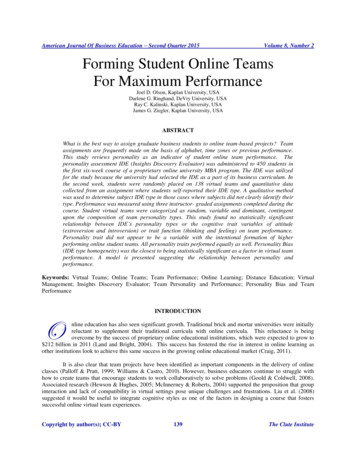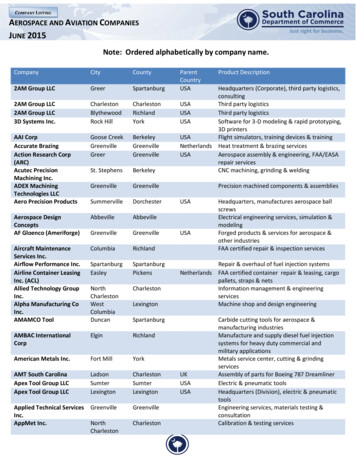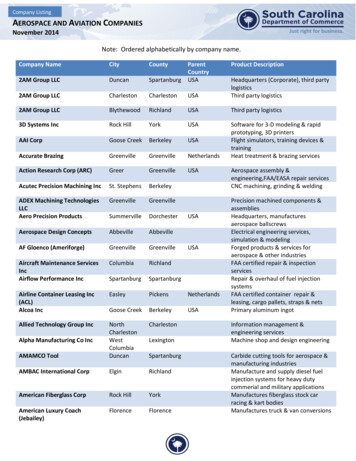
Transcription
Business / MarketingMarketingSECOND EDITIONA fully updated edition from the leading MBAmarketing programThe first edition of Kellogg on Marketing set a high standard with a cutting-edgepresentation of the best knowledge and practices in the field. Now, the SecondEdition of this benchmark guide breaks new ground, providing fresh perspectiveson timeless fundamental issues as well as the latest ideas. This includes: The latest emerging opportunities and challenges for marketers The branding uses of social media and consumer-generated media Recent developments in advertising, distribution, pricing, and branding inPhoto: Evanstone PhotographicBOBBY J. CALDER is theCharles H. Kellstadt Professor ofMarketing and the current chairperson of the Department ofMarketing at the Kellogg Schoolof Management, NorthwesternUniversity. Previously, he hastaught at the Wharton School,University of Pennsylvania, and has been a consultant for Booz Allen Hamilton. He is the author ofnumerous research studies and articles. He has beena consultant to companies such as Aetna, BristolMyers Squibb, CEMEX, Coca-Cola, General Electric,General Motors, McDonald’s, Motorola, Prudential,Tribune Co., and Time Warner.markets around the world Connecting marketing to other functional areas such as sales andoperations for increased impact Customer-centric practices for frontline employees, salespeople, those inoperations, and others Techniques for marketing to lower-income consumers Using innovation to find new customers in a hypercompetitive economy Strategies for effective social innovation Management of product lines and brand portfolios Internal branding And moreKellogg on MarketingPhoto: Evanstone PhotographicALICE M. TYBOUT is theHarold T. Martin Professorof Marketing and a formerchairperson of the MarketingDepartment at the KelloggSchool of Management,Northwestern University.She is academic director ofthe consumer marketing strategy program and thebranding program at Kellogg’s Allen Center, theauthor of more than forty articles and book chapters, a consultant for leading companies, including Abbott Laboratories, Coca-Cola Company, andPfizer, and a member of the board of directors ofRHR International.TyboutCalderKelloggonWhether you’re new to marketing or have manyyears’ experience, Kellogg on Marketing, Second Editionsupplies you with both strategic insights and on-theground examples so you can deepen your knowledgebase and create winning, profitable marketing plans.KelloggonMarketingSECOND EDITIONTHE MARKETING FACULTY OFTHE KELLOGG SCHOOL OF MANAGEMENTEDITED BYAlice M. Tybout and Bobby J. CalderJacket Design: Loretta LeivaSECONDEDITIONFOREWORD BYPHILIP KOTLER978-0-470-58014-1 29.95 USA/ 35.95 CANA fresh take on core marketing conceptsand key contemporary issuesWhen executives and professionals wantthought leadership in marketing, theylook to one place: The Kellogg Schoolof Management. For years, Kellogg has set thestandard for combining cutting-edge research withreal-world insight, sending its graduates to themarketing departments of today’s—and tomorrow’s—most dynamic enterprises. Now, Kellogg onMarketing, Second Edition gives you unique accessto a complete course on marketing from this program’s renowned faculty.In fully updated and all-new chapters, this SecondEdition takes on all the key questions and challenges you’ll find in the current marketing landscape,including social media, product innovation, usergenerated branding, and more. At the same time, theexpert authors convincingly demonstrate how—andwhich—fundamental concepts continue to guidesound marketing practice.Building on the coverage in the now-classic first edition, this Second Edition features new material andperspectives on: The changing nature of distribution, includingnew digital channels Advertising on blogs, Web sites, YouTube, andmore The effects of social media on branding Marketing to customers in underdeveloped ordeveloping markets Innovating successfully in an age of shortproduct life cycles Adopting a customer focus throughout yourorganization And much more
P1: OTA/XYZP2: ABCfmJWBT313-TyboutJuly 1, 201018:50Printer Name: Courier Westford, Westford, MA
P1: OTA/XYZP2: ABCfmJWBT313-TyboutJuly 1, 201018:50Printer Name: Courier Westford, Westford, MAKellogg onMarketing
P1: OTA/XYZP2: ABCfmJWBT313-TyboutJuly 1, 201018:50Printer Name: Courier Westford, Westford, MA
P1: OTA/XYZP2: ABCfmJWBT313-TyboutJuly 1, 201018:50Printer Name: Courier Westford, Westford, MAKellogg onMarketingSecond EditionEdited byAlice M. TyboutBobby J. CalderJohn Wiley & Sons, Inc.
P1: OTA/XYZP2: ABCfmJWBT313-TyboutJuly 1, 201018:50Printer Name: Courier Westford, Westford, MAC 2010 by Northwestern University. All rights reserved.Copyright Published by John Wiley & Sons, Inc., Hoboken, New Jersey.Published simultaneously in Canada.No part of this publication may be reproduced, stored in a retrieval system, or transmitted inany form or by any means, electronic, mechanical, photocopying, recording, scanning, orotherwise, except as permitted under Section 107 or 108 of the 1976 United States CopyrightAct, without either the prior written permission of the Publisher, or authorization throughpayment of the appropriate per-copy fee to the Copyright Clearance Center, Inc., 222Rosewood Drive, Danvers, MA 01923, (978) 750-8400, fax (978) 646-8600, or on the web atwww.copyright.com. Requests to the Publisher for permission should be addressed to thePermissions Department, John Wiley & Sons, Inc., 111 River Street, Hoboken, NJ 07030,(201) 748-6011, fax (201) 748-6008, or online at http://www.wiley.com/go/permissions.Limit of Liability/Disclaimer of Warranty: While the Publisher and author have used their bestefforts in preparing this book, they make no representations or warranties with respect to theaccuracy or completeness of the contents of this book and specifically disclaim any impliedwarranties of merchantability or fitness for a particular purpose. No warranty may be createdor extended by sales representatives or written sales materials. The advice and strategiescontained herein may not be suitable for your situation. You should consult with a professionalwhere appropriate. Neither the Publisher nor author shall be liable for any loss of profit or anyother commercial damages, including but not limited to special, incidental, consequential, orother damages.For general information on our other products and services or for technical support, pleasecontact our Customer Care Department within the United States at (800) 762-2974, outsidethe United States at (317) 572-3993 or fax (317) 572-4002.Wiley also publishes its books in a variety of electronic formats. Some content that appears inprint may not be available in electronic books. For more information about Wiley products,visit our web site at www.wiley.com.Library of Congress Cataloging-in-Publication Data:Kellogg on marketing / [edited by] Alice M. Tybout, Bobby J. Calder. – 2nd ed.p. cm.Includes bibliographical references and index.ISBN 978-0-470-58014-1 (hardback); ISBN 978-0-470-87762-3 (ebk);ISBN 978-0-470-87738-8 (ebk); ISBN 978-0-470-87763-0 (ebk)1. Marketing. I. Tybout, Alice M. II. Calder, Bobby J. III. J.L. KelloggGraduate School of Management.HF5415.K4443 2010658.8–dc222010010869Printed in the United States of America.10 9 8 7 6 5 4 3 2 1
P1: OTA/XYZP2: ABCfmJWBT313-TyboutJuly 1, 201018:50Printer Name: Courier Westford, Westford, MAContentsForewordThinking About MarketingixPhilip KotlerPrefacexiAlice M. Tybout and Bobby J. CalderAcknowledgmentsxixSection OneDeveloping a Marketing StrategyChapter 1Creating Customers and Shaping the Competitive Game3Gregory S. CarpenterChapter 2Identifying Market Segments and Selecting Targets26Alice M. Tybout and Kent GraysonChapter 3Marketing Research and Understanding ConsumersBobby J. CalderChapter 4Developing a Compelling Brand PositioningAlice M. Tybout and Brian Sternthalv7356
P1: OTA/XYZP2: ABCfmJWBT313-TyboutJuly 1, 2010vi18:50Printer Name: Courier Westford, Westford, MAContentsChapter 5Writing a Brand Positioning Statement and TranslatingIt into Brand Design92Bobby J. CalderChapter 6Creating and Managing Brands112Alice M. Tybout and Gregory S. CarpenterSection TwoImplementing the StrategyChapter 7Making the Brand Come Alive within Your Organization145Lisa Fortini-CampbellChapter 8The Sandwich Strategy: Managing New Products and Services for ValueCreation and Value Capture161Dipak C. JainChapter 9Pricing for Profit182Lakshman KrishnamurthiChapter 10Advertising Strategy209Dereck D. Rucker and Brian SternthalChapter 11Marketing Channel Design and Management232Anne T. CoughlanChapter 12Building a Winning Sales Force258Andris A. Zoltners, Prabhakant Sinha, and Sally E. Lorimer
P1: OTA/XYZP2: ABCfmJWBT313-TyboutJuly 1, 201018:50Printer Name: Courier Westford, Westford, MAviiContentsSection ThreePerspectives on ContemporaryIssues in MarketingChapter 13Marketing to Consumers at the Bottom of the Pyramid287Bobby J. Calder, Richard Kolsky, and Maria Flores LetelierChapter 14The New Influence of Social Media307Lakshman Krishnamurthi and Shyam GopinathChapter 15From the Wheel to Twitter: Where Do Innovations Come From?David GalChapter 16Brand-Led Innovation332Bobby J. Calder and Edward S. CalderChapter 17Managing Product Assortments: Insightsfrom Consumer Psychology348Ryan Hamilton and Alexander ChernevChapter 18Goal-Driven Marketing Research: The Answerto a Shrinking Budget361Angela Y. LeeChapter 19Aligning Sales and Marketing to Enhance Customer Value and DriveCompany Results373Andris A. Zoltners, Prabhakant Sinha, and Sally E. Lorimer319
P1: OTA/XYZP2: ABCfmJWBT313-TyboutJuly 1, 2010viii18:50Printer Name: Courier Westford, Westford, MAContentsChapter 20Creating Superior Value By Managing the Marketing–OperationsManagement Interface393Anne T. Coughlan and Jeffrey D. ShulmanIndex409
P1: OTA/XYZP2: ABCfmJWBT313-TyboutJuly 1, 201018:50Printer Name: Courier Westford, Westford, MAForewordThinking about MarketingIn introducing the first edition of thislargely revised and expanded book, Kellogg on Marketing, I pointed out that abook that seriously examined marketing thinking was greatly needed becausemarkets were changing faster than marketing. Markets are changing so fast thatthey hardly resemble those of the 1990s, let alone the 1950s. Yet many of theideas and frameworks that marketers use have not kept pace.No matter what features of markets you look at, the pace of change hasincreased. Advertising has exploded beyond the former mainstay of the television commercial to appear on almost anything that can serve as a medium:blogs, web sites, YouTube, Second Life, electronic billboards, even shoppingbags and napkins. Distribution is not confined to one or two physical channelsbut increasingly takes myriad forms, including the proliferating digital channels. Pricing becomes ever more complex with the pressures of recession andinternational competition. Brands continue to be vital, but they are more andmore difficult to establish and keep relevant to consumers.On top of all this, the economy is awash in hypercompetition. With so manycompanies chasing the same markets, the role of innovation and finding newconsumers has become necessary for survival. This is a time when everyonein a company, not just the marketers and salespeople, need to think aboutmarketing and collaborate in carrying it out.The purpose of this new book is to help managers think about marketingin ways that correspond to what is happening in markets around the world.It revisits the fundamental concepts that continue to guide sound marketingpractice, updating these concepts to reflect the current market conditions.In addition, the authors discuss the many emerging opportunities and challenges for marketers, drawing on scholarly research as well as their years ofexperience working with leading companies around the globe. They offerimportant insights on topics such as marketing to consumers at the bottom ofthe economic pyramid, the effect of social media on branding, and strategiesfor effective innovation. They also discuss the connection between marketingix
P1: OTA/XYZP2: ABCfmJWBT313-TyboutJuly 1, 2010x18:50Printer Name: Courier Westford, Westford, MAForewordand other functional areas, such as sales and operations, and provide strategiespromoting cooperation and coordination between these areas.Kellogg on Marketing, Second Edition, is unique. Textbooks are written byacademic scholars with the goal of presenting students of marketing with acomprehensive overview of the topic. Popular business books on marketingare written by managers, consultants, and the occasional academic, typicallywith the goal of addressing a topical issue and offering a solution based on theauthors’ practical experiences. This book does both and more. It covers thebasics and provides a point of view on current topics. But most important, itraises key questions and challenges readers to think about them in new ways.If you are new to marketing, this book is as good a place to begin as you willfind. If you think you know all you need to know about branding, marketingresearch, advertising, pricing, distribution, innovation, and so on, you stillmust read this book. You’ll likely be surprised at what you’ll learn.As markets become ever more complex, we all need to think and learnmore about marketing. I have always said that “marketing takes a few weeksto learn but a lifetime to master.”Philip KotlerEvanston, IllinoisJuly 2010
P1: OTA/XYZP2: ABCfmJWBT313-TyboutJuly 1, 201018:50Printer Name: Courier Westford, Westford, MAPrefaceW hen Kellogg on Marketing was published in 2001, the goal was to share the unique perspective of the Kelloggmarketing faculty with colleagues, students, alumni, and the larger businesscommunity. The initial volume was well-received and led to subsequent booksin the series that address specific marketing topics in depth: Kellogg on IntegratedMarketing (2003), Kellogg on Branding (2005), and Kellogg on Advertising & Media(2008).A decade later, the principles of sound marketing strategy addressed inKellogg on Marketing remain the same, but new challenges and opportunitiesexist. To illustrate with a few of the many such issues discussed in this volume:r Savvy companies recognize that their success depends on adopting acustomer focus. But exactly what does that mean in terms of specificactivities for frontline employees, salespeople, those in operations, andso forth?r Marketers contend with ever-shorter product life cycles and increasedpressure to innovate in order to sustain a competitive advantage. How canfirms innovate more successfully?r Consumers “surf,” “text,” “tweet,” and watch YouTube, allowing information to spread virally, sometimes to the benefit and sometimes to thedetriment of a brand. What are the implications of these new media onmanaging a brand? Who’s really in charge of the brand, anyway?r There are billions of potential customers to be won in underdevelopedand developing markets. How can companies adapt their offerings andchannels to accommodate these consumers’ generally low incomes and thelimited distribution systems that characterize these markets?With an eye to topical issues like these, we have created Kellogg on Marketing, Second Edition. This new edition contains significantly revised and updatedchapters that address core concepts needed for the development and implementation of sound marketing strategy. In addition, we present eight entirelyxi
P1: OTA/XYZP2: ABCfmJWBT313-TyboutJuly 1, 2010xii18:50Printer Name: Courier Westford, Westford, MAPrefacenew chapters that offer the perspective of Kellogg faculty on emerging issuesthat are important for the future of marketing.As with this book, a decade later the Kellogg marketing faculty is bothsimilar in some ways and different in others. Many of the faculty memberswho authored chapters in the original edition of Kellogg on Marketing are stillactive members of the department.They have been joined by new faculty, whobring with them fresh perspectives.Overview of the BookThe book is divided into three sections. Chapters in Section One, entitled“Developing a Marketing Strategy,” cover foundational concepts and tools forbuilding a marketing strategy. In Chapter 1, “Creating Customers and Shapingthe Competitive Game,” Gregory S. Carpenter sets the stage by reminding thereader of Peter Drucker’s assertion that the fundamental purpose of business isto create a customer. The challenge is how to do so in the face of customerswho don’t always know what they want and competitors who are quick toimitate any differentiation. The answer, Carpenter argues, lies in understandingthat, “Rather than a race to meet some prespecified consumer objective,competition becomes a struggle to influence what buyers know and, as aresult, how they behave.” He introduces the “Market Paradigm,” a conceptthat captures the knowledge consumers acquire and the social consensus thatemerges from it as a means of defining the competitive landscape. He thendiscusses competitive strategies, such as market pioneering, fast following,differentiation, and refining markets, that can be used to create value in theMarket Paradigm.In Chapter 2, “Identifying Market Segments and Selecting Targets,” AliceM. Tybout and Kent Grayson begin with the premise that any firm’s offeringsare unlikely to appeal to everyone. Therefore, creating customers requiressegmenting markets and selecting the most attractive targets. They recommendthat companies begin by segmenting customers on the basis of their currentbehavior or usage patterns, then describe the resulting subgroups in terms oftheir distinctive demographic and psychographic characteristics, as well as theirprofit potential. Targets are finally prioritized on the basis of a “path-of-leastresistance” strategy, where targets that are likely to generate the highest returnper marketing dollar invested receive first priority.Once a firm has identified a target group of consumers, it then shouldseek insight into the motivations underlying their behavior. Because a company and its customers have inherently different perspectives, market researchis employed to bridge the gap between them. In Chapter 3, “Marketing
P1: OTA/XYZP2: ABCfmJWBT313-TyboutJuly 1, 201018:50Printer Name: Courier Westford, Westford, MAPrefacexiiiResearch and Understanding Consumers,” Bobby J. Calder offers a provocative perspective on how to make effective use of marketing research. He encourages the marketer to focus less on the technique employed or the amountof data collected and more on achieving an understanding of customers and aplausible explanation for their behavior.A deep understanding of targeted customers’ beliefs and motivations servesas the foundation for developing the brand’s positioning. A brand’s positioning is the specific, intended meaning of the brand in the mind of targetedcustomers. As such, it is a guidepost for making decisions about all of the elements of the brand that consumers experience. Brand positioning is so centralto an effective marketing strategy that we devote two chapters to this topic. InChapter 4, “Developing a Compelling Brand Positioning,” Alice M. Tyboutand Brian Sternthal offer two complementary perspectives that can be usedto build a strong position. Their competition-based approach emphasizes howa brand is similar to competitors’ offerings on some dimensions and superiorto these offerings on other dimensions. Their customer-based approach focuses on how the distinguishing features of a brand create abstract benefits thatare related to customers’ goals. In Chapter 5, “Writing a Brand PositioningStatement and Translating It into Brand Design,” Bobby J. Calder then digsinto the task of arriving at a single statement that succinctly summarizes thebrand positioning. He discusses how a brand’s positioning may evolve overtime as brand meanings deepen, then recommends that positioning statementsbe developed in the context of designing the verbal and visual brand elementsthat will convey the positioning to consumers.Section One concludes with Chapter 6, “Creating and Managing Brands.”In this chapter, Alice M. Tybout and Gregory S. Carpenter discuss the processof building a brand and describe three types of brands that companies build:functional, image, and experiential brands. They then explore the uniquechallenges associated with managing each type of brand.Chapters in Section Two, entitled “Implementing the Strategy,” address thetranslation of a brand’s positioning into all the things that targeted customersexperience: the level of service they receive when they call the company’s800 number; the actual features of the product or service offering; the price;the representation of the product in communications such as advertising andsales force presentations; and the purchase experience. In Chapter 7, “Making the Brand Come Alive within Your Organization,” Lisa Fortini-Campbelladdresses the link between the intended meaning of the brand (brand positioning) and what happens inside the firm. She argues that an organization’s culture is its brand. If people within the organization are not aware ofand fully committed to the brand’s position, be it one of superior product
P1: OTA/XYZP2: ABCfmJWBT313-TyboutJuly 1, 2010xiv18:50Printer Name: Courier Westford, Westford, MAPrefaceperformance, hassle-free customer service, quick, reliable delivery or lowestcost, customers’ experiences will fall short and the brand position will existonly in the mind of the marketing manager who developed it. To ensurethat the company’s culture supports the brand positioning, Fortini-Campbellrecommends paying close attention to four key dimensions of the internal organization: hiring, cultural storytelling, job design, rewards and incentives, andleadership.In Chapter 8, “The Sandwich Strategy: Managing New Products and Services for Value Creation and Value Capture,” Dipak C. Jain presents a framework for launching new products and services that are a “triple win”—thosethat create and capture value for the company, its partners, and its customers.He argues that when a company is attacked by price competition, it shouldrespond by creating at least two new offerings that effectively “sandwich”the competition by attacking it from opposite ends of the value chain: belowand above. More generally, he offers guidelines for managing a product linehorizontally (i.e., the level of variety at a particular price point) and vertically(i.e., the range of price points offered), with the goal of moving the firm’scustomers up the value chain.The issue of price competition, as well as other considerations in settingprice, is discussed further in Chapter 9, “Pricing for Profit.” Here, LakshmanKrishnamurthi offers a strategic approach to making pricing decisions, whichbegins with a determination of whether gaining market share or increasingprofits is the firm’s top priority. Then, five key determinants of price—cost,customer value, competition, the distribution channel, and regulation—arediscussed in detail. The overarching theme of the chapter is that indeed pricemust be set to cover the firm’s costs, allow channel partners to make a profit,and comply with regulations. But ultimately the price that a firm can charge isdetermined by the value of the firm’s offering (based on functional, economic,and emotional benefits), as perceived by targeted customers and in comparisonto the competitive offerings under consideration.In Chapter 10, “Advertising Strategy,” Derek D. Rucker and Brian Sternthaladdress the issue of communicating a brand’s position through media. First,they discuss the role of advertising and when it is appropriate to use advertisingrather than other methods such as personal selling to communicate the brandmessage. Next, they describe the ways consumers use advertising to makedecisions and outline strategies for increasing consumers’ engagement withadvertising through creative and media strategies. They then present alternativestrategies for presenting the brand message and evaluating its effectiveness. Akey insight is that mere recall of an advertising message is insufficient to gaugeits effectiveness.
P1: OTA/XYZP2: ABCfmJWBT313-TyboutJuly 1, 201018:50Printer Name: Courier Westford, Westford, MAPrefacexvNo matter how appealing a product or service may be, customers cannot buyit if it isn’t made available through some channel of distribution. In Chapter 11,“Marketing Channel Design and Management,” Anne T. Coughlan providesa framework for designing and managing channels of distribution. She arguesthat channel design must begin with an understanding of end-users’ demandsfor the service outputs of the channel (i.e., their need for quick delivery,assortment and variety, bulk breaking, and the like), which typically varyby the type of customer and use occasion. This knowledge is then used tocreate the optimal channel structure for meeting these demands. Channelmanagement, in turn, requires an understanding of each channel member’ssources of power and dependence in order to manage any conflict amongthese channel members so that the goal of coordination is achieved. Theframework presented is illustrated with brief case studies, including one thatdescribes how a company developed an innovative channel to distribute itsproducts to low-income consumers in Mexico.In many situations (especially business-to-business), salespeople play a critical role in promoting and distributing a company’s products and services.Indeed, as Andris A. Zoltners, Prabhakant Sinha, and Sally E. Lorimer notein Chapter 12, “Building a Winning Sales Force,” for some such customers,the salesperson is the company. Yet salespeople often enjoy autonomy thatmakes them difficult to control, direct, and manage. The authors begin byidentifying the conditions under which a company will benefit from personalselling and discuss when the sales function should be outsourced versus managed internally. They then address the challenge of motivating and managinga sales force. Five key drivers of sales force effectiveness are identified, and bestpractices for managing these drivers are discussed.Chapters in Section Three, “Perspectives on Contemporary Issues inMarketing,” focus on key challenges and opportunities for marketers in thecurrent environment. The section begins with Chapter 13 by Bobby J. Calder,Richard Kolsky, and Maria Flores Letelier (“Marketing to Consumers at theBottom of the Pyramid”), in which the authors share lessons they learnedabout marketing to the poor from their extensive experience with CEMEX’sPatrimonio Hoy program in Mexico. This case study, which is an ongoingexercise in experimentation and learning, leads to important insights abouthow companies must adapt their traditional approach in order to succeed inmarketing to consumers at the bottom of the pyramid.At the other end of the income spectrum, marketers grapple with thebenefits and liabilities of new social media, such as blogs, Facebook, Twitter,YouTube, web forums, and more. In Chapter 14, “The New Influence ofSocial Media,” Lakshman Krishnamurthi and Shyam Gopinath note that such
P1: OTA/XYZP2: ABCfmJWBT313-TyboutJuly 1, 2010xvi18:50Printer Name: Courier Westford, Westford, MAPrefacemedia can serve as powerful tools to gain customer feedback but can alsoweaken the marketer’s control over the brand message. They argue that socialmedia engagement is not for all companies and offer a list of questions for firmsdeciding whether to commit resources to social networking sites. In addition,they review emerging academic research that documents the impact of onlineword-of-mouth and online customer ratings.Effective innovation has been a long-standing challenge for marketers. Itsimportance has only increased as product lifecycles have shortened. Two chapters offer perspectives on how a company can innovate effectively. In Chapter15, “From the Wheel to Twitter: Where Do Innovations Come From?” DavidGal draws on lessons from history regarding the source of successful innovations. His analysis yields three key insights: (1) The focus of innovation shouldbe on novel applications of existing inventions rather than on creating newinventions; (2) the key to successful innovation in a marketing context is theidentification of unarticulated customer needs and the envisioning of creativeapplications to fulfill those needs; and (3) the best sources of ideas for innovation are found by looking outside the company and the industry in whichit competes. In Chapter 16, “Brand-Led Innovation,” Bobby J. Calder andEdward S. Calder extend the discussion of innovation by noting that thereare many paths to successful innovation. Traditionally, companies have reliedon customer insight, technological advances, or some combination of thesefactors as the source of innovations. More recently, innovations have emergedfrom insights about ways to improve a business model or product design. Theauthors propose an additional approach to innovation: brand-led innovation.This approach uses a brand’s positioning and abstract meanings in the mindsof consumers as a springboard for launching new offerings in a category thatmight otherwise be difficult to penetrate without fresh insight or a technological advance.Companies’ efforts to address the variation in customers’ needs often leadsto a large assortment of options in a product category. Intuitively, it mightseem that this benefits consumers by increasing the odds that they will find anoption that is just right for them. However, as Ryan Hamilton and AlexanderChernev document in Chapter 17, “Managing Product Assortments: Insightsfrom Consumer Psychology,” there is a downside to offering a large assortment.Too many options can create “choice overload” for consumers, leading someto opt out of choosing altogether. The
Kellogg on Marketing Kellogg Kellogg MarketingMarketing onon Kellogg Kellogg Marketing onon THE MARKETING FACULTY OF THE KELLOGG SCHOOL OF MANAGEMENT EDITED BY Alice M. Tybout and Bobby J. Calder SECOND EDITION FOREWORD BY PHILIP KOTLER 978-0-470-58014-1 A fresh take











